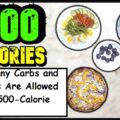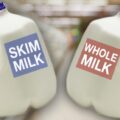No products in the cart.
How Many Carbs and Proteins Are Allowed on a 1,500-Calorie Diet: Let’s give a nod to protein—it’s basically the handyman of the human body. It not only builds and repairs cells but also reinforces your immune system. And if you’re aiming to shed a few pounds, adding a good dose of protein to each meal might be the trick. High-protein foods can help you feel fuller on fewer calories, giving you a bit of an edge in the weight-loss game. This 1,500-calorie meal plan is stocked with salmon, chicken, edamame, eggs, and chickpeas—all heavyweights in the protein department—to keep you well above the 50-gram daily minimum.
And, because even a low-calorie diet needs some balance, these meals feature a cast of colorful veggies, fruits, whole grains, and healthy fats to keep things interesting. Paired well, these components come together to form a week of meals that fill you up without overloading your calorie count. Plus, for those who like a jump-start, there are meal-prep tips to make the coming week smooth sailing.
The Dietary Guidelines for Americans suggest that a moderately active adult should consume between 2,000 and 2,800 calories daily. Sedentary folks? They still need around 1,800 to maintain weight. Cutting down to 1,500 calories can jump-start weight loss, especially with the help of a calorie calculator. But here’s the deal—cutting calories doesn’t mean cutting nutrition. A proper intake of carbs and protein fuels your body, preserving lean muscle and keeping energy levels stable throughout your journey.
Macros for a 1500-Calorie High-Protein Meal Plan
Macronutrients—those little building blocks of energy we all need. Carbs keep you moving, while proteins build and repair your tissue, enzymes, and hormones. The National Academies recommend that adults get 45 to 65 percent of their calories from carbohydrates; on a 1,500-calorie diet, that translates to about 675–975 calories from carbs. Protein, on the other hand, should cover 10 to 35 percent, or 150–525 calories, depending on individual needs like age, weight, activity level, and health conditions.
A more active lifestyle? You may need to bump up the carbs and protein to support energy and muscle recovery. But, as always, a quick chat with your doctor or nutritionist will help iron out the details so you get what you need—without overdoing it.
Tracking Those Grams: Are You Getting Enough?
Knowing the calorie-per-gram count is key. Both protein and carbs pack 4 calories per gram, which means you’ll want to keep an eye on those daily values listed on food labels. If you’re aiming for, say, 50 percent carbs and 20 percent protein in your diet, that’s about 188 grams of carbs and 75 grams of protein each day.
Luckily, labels make packaged foods easy to decode, but whole foods need a bit more sleuthing. Try the USDA’s Food Composition Database for quick info on the go.
Low-Carb or High-Protein: What’s the Real Deal?
Jump into the diet scene, and you’re bound to hear arguments for low-carb, high-protein, or even both. Yet, according to the 2018 DIETFITS study published in the Journal of the American Medical Association, the real winner for weight loss isn’t any one diet but maintaining a calorie deficit. Calorie math still reigns supreme.
Carbs and proteins do have their unique perks. Protein is the most filling macronutrient, according to a 2015 review in Trends in Food Science & Technology, so a protein-packed meal may help keep you satisfied longer. And complex carbs, like those in veggies and whole grains, pack fiber, which digests slower than most foods and keeps hunger at bay.
So, do you need to go overboard? Hardly. Just get enough of each—and make it the right type.
Best Protein and Carbohydrate Foods for Weight Loss
Choosing quality carbs and proteins is pretty straightforward. Whole foods are the MVPs, while packaged and processed foods should warm the bench. Processed goodies like chips and sugary snacks are high in refined carbs, which lack fiber and can spike blood sugar, only to leave you crashing and craving more.
When it comes to protein, lean meats, fish, eggs, tofu, and beans will serve you better than their high-fat counterparts like bacon or fried chicken. Save red meat for occasional indulgences, and your heart will thank you. 1500 Calories Pre-Bariatric Meal Plan Source to download.
130
Shares
Emely RMD
Emely RMD is a passionate WordPress designer, blogger, and content creator with a love for exploring diverse topics. She enjoys writing about love, self-improvement, motivation, travel, money, and more. Emely combines her expertise in online careers with her enthusiasm for crafting engaging content, aiming to inspire and inform her audience through her thoughtful and varied writings.









Leave a Reply